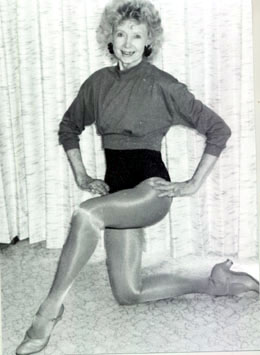Beloved dancer shares talent with her community
By Teri Baker

She has about her that elegance and effortless grace of which poets speak with silver tongues. Long, slender legs exquisitely positioned, Eleanor Leight demonstrates a ballet move. A moment later she executes a complicated tap dance. It is hard to believe that this supple, youthful woman is an octogenarian.
Eleanor teaches dance classes for children after school in Snohomish, as well as adults in tap, ballet, exercise and ballroom dancing for adults through the community schools program. The former Rockette also directs The Leight Fantastics, a group she began 26 years ago after a woman approached her and said that she had always wanted to tap. That woman was the first of a long line of adults to discover the joy of dance and the magic that is Eleanor Leight.
Prior to forming the Leight Fantastics, Eleanor, who has lifelong experience in the performing arts, had already written and produced the first four of Snohomish Historical Society’s annual vaudeville shows and was one of the driving forces of the Snohomish Bicentennial Committee, helping put together a production involving 300 people.
Born March 13, 1922 in Philadelphia, Eleanor started dancing when she was eight. Stage shows were all the rage, and her uncle, a stage manager, used to sneak little Eleanor and her sister, Frances, backstage.
“The first time we saw the dancing, we knew!” Eleanor says, recalling the delight and wonder of that moment. The sisters took free lessons at the local recreation center and were soon performing. Eleanor was fascinated by all the forms of dance, but her real love has always been ballet. At age 17 she began teaching at Philadelphia’s Littlefield Ballet, but at 5’ 7” she was simply too tall to be part of the cast. She concentrated on tap dancing and when she was 20, auditioned for the Radio City Music Hall Rockettes.
“I guess I could do the kicks and had the ‘look’ they wanted, so I got in,” Eleanor says modestly. She had traveled the vaudeville circuit with George White’s Scandals doing four or five shows a day as accompaniment to movies. Doing four shows a day with the Rockettes at New York’s Rockefeller Center was a walk in the park for her.
“It was not as demanding as some things are,” she reflects. “There would be only one big number that was maybe five minutes long. Then, we’d often do one other thing, like dress up in gowns and furs for a nightclub scene or sit in a swing and be pushed during another number.
Eleanor was with the Rockettes for a year in New York and then another year in Europe on a USO tour as part of Radio City’s contribution to the war effort. The war in Europe ended while the show was in rehearsal, but the danger had not passed. The show involved 80 people and 20 tons of scenery, all transported from New York by a ship forced to negotiate mine fields, and then moved throughout Europe on weapons’ carriers and trains. “In the countryside, the SS was still coming down and capturing people,” Eleanor says. “It was a scary time. The girls didn’t go very far away and always went by twos for safety.”
Eleanor and her companions saw for themselves the unspeakable horror the Nazis created. She visited concentration camps and sat in the press box, wearing a headset that provided instant translation, at Nuremberg when Hermann Goering was tried for war crimes.
A shadow clouds her eyes at the memory, and then her positive nature asserts itself. Eleanor chooses to concentrate on how well she and her fellow performers were received. She says, smiling, “It was my experience that people really liked Americans.”
After her return to Philadelphia, Eleanor taught dance and, using the stage name Eleanor Russell, appeared in a solo act for nine years. Booked out of New York, she performed numerous club dates and at lavish private parties. She says she shunned the nightclub scene because it depended on “mixing with people who were not always sober” and “staying up until all hours.”
She married Wes Leight, a boat builder, and moved to Long Island, NY. As the family grew, Eleanor continued to teach dance. Wes went to Eugene, Oregon to go into construction work and sent for his family a year later. Eleanor packed up her five boys, an Airedale and a guinea pig and headed west on the train. In the 1960s, the Leights moved to Snohomish County.
Eleanor’s family is still a big part of her life and of her annual revue. Steve serves as stage manner, Cliff takes publicity photos and David helps with art work. When he’s in the area, Andrew, helps with the music and plays trombone in the show’s Dixieland band. Peter helps whenever he’s needed and runs the spotlight.
“We all used to dance in the shows,” Peter says with an affectionate glance at his mother. “Now we do other things to help out.”
Eleanor is proud of her sons and of her husband’s influence on the family’s life. But during the spring, the family ball is definitely in Eleanor’s court. There are more than 100 people involved in the vaudeville revue held each Mother’s Day weekend. It’s sometimes hard to get Eleanor to acknowledge her own considerable contribution to the productions because she would rather spotlight the talent and accomplishments of others.
At 85, her kicks, although not quite as high as when she was a Rockette, are still impressive. She remains a model of professionalism, patience, hard work and perseverance. With these qualities, along with her considerable talent, warmth, grace and spirit, it is little wonder that Eleanor Leight is one of Snohomish’s most beloved citizens.
Sources: Personal interviews with Eleanor Leight, 1994 and 2007.
© Theresa (Teri) A. Baker, 1994 – 2007
All rights reserved.; WLP Story # 43
